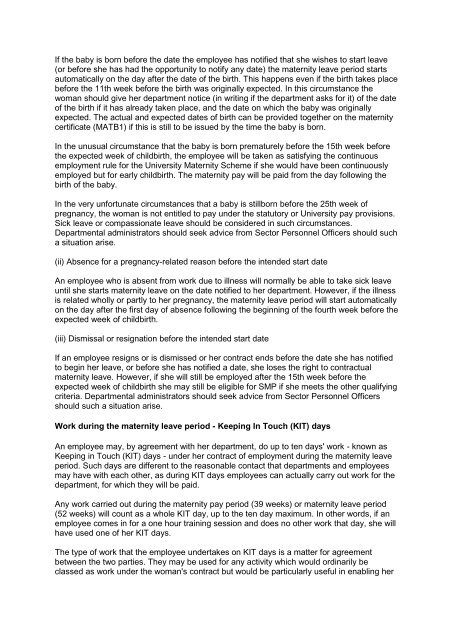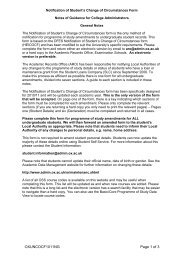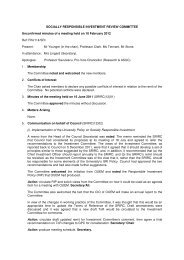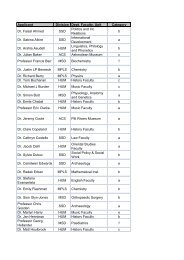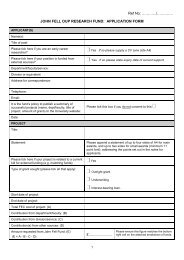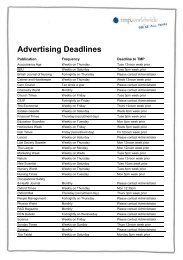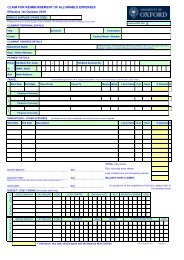Maternity leave - University of Oxford
Maternity leave - University of Oxford
Maternity leave - University of Oxford
Create successful ePaper yourself
Turn your PDF publications into a flip-book with our unique Google optimized e-Paper software.
If the baby is born before the date the employee has notified that she wishes to start <strong>leave</strong>(or before she has had the opportunity to notify any date) the maternity <strong>leave</strong> period startsautomatically on the day after the date <strong>of</strong> the birth. This happens even if the birth takes placebefore the 11th week before the birth was originally expected. In this circumstance thewoman should give her department notice (in writing if the department asks for it) <strong>of</strong> the date<strong>of</strong> the birth if it has already taken place, and the date on which the baby was originallyexpected. The actual and expected dates <strong>of</strong> birth can be provided together on the maternitycertificate (MATB1) if this is still to be issued by the time the baby is born.In the unusual circumstance that the baby is born prematurely before the 15th week beforethe expected week <strong>of</strong> childbirth, the employee will be taken as satisfying the continuousemployment rule for the <strong>University</strong> <strong>Maternity</strong> Scheme if she would have been continuouslyemployed but for early childbirth. The maternity pay will be paid from the day following thebirth <strong>of</strong> the baby.In the very unfortunate circumstances that a baby is stillborn before the 25th week <strong>of</strong>pregnancy, the woman is not entitled to pay under the statutory or <strong>University</strong> pay provisions.Sick <strong>leave</strong> or compassionate <strong>leave</strong> should be considered in such circumstances.Departmental administrators should seek advice from Sector Personnel Officers should sucha situation arise.(ii) Absence for a pregnancy-related reason before the intended start dateAn employee who is absent from work due to illness will normally be able to take sick <strong>leave</strong>until she starts maternity <strong>leave</strong> on the date notified to her department. However, if the illnessis related wholly or partly to her pregnancy, the maternity <strong>leave</strong> period will start automaticallyon the day after the first day <strong>of</strong> absence following the beginning <strong>of</strong> the fourth week before theexpected week <strong>of</strong> childbirth.(iii) Dismissal or resignation before the intended start dateIf an employee resigns or is dismissed or her contract ends before the date she has notifiedto begin her <strong>leave</strong>, or before she has notified a date, she loses the right to contractualmaternity <strong>leave</strong>. However, if she will still be employed after the 15th week before theexpected week <strong>of</strong> childbirth she may still be eligible for SMP if she meets the other qualifyingcriteria. Departmental administrators should seek advice from Sector Personnel Officersshould such a situation arise.Work during the maternity <strong>leave</strong> period - Keeping In Touch (KIT) daysAn employee may, by agreement with her department, do up to ten days' work - known asKeeping in Touch (KIT) days - under her contract <strong>of</strong> employment during the maternity <strong>leave</strong>period. Such days are different to the reasonable contact that departments and employeesmay have with each other, as during KIT days employees can actually carry out work for thedepartment, for which they will be paid.Any work carried out during the maternity pay period (39 weeks) or maternity <strong>leave</strong> period(52 weeks) will count as a whole KIT day, up to the ten day maximum. In other words, if anemployee comes in for a one hour training session and does no other work that day, she willhave used one <strong>of</strong> her KIT days.The type <strong>of</strong> work that the employee undertakes on KIT days is a matter for agreementbetween the two parties. They may be used for any activity which would ordinarily beclassed as work under the woman's contract but would be particularly useful in enabling her


